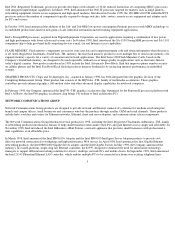Intel 1998 Annual Report Download - page 7
Download and view the complete annual report
Please find page 7 of the 1998 Intel annual report below. You can navigate through the pages in the report by either clicking on the pages listed below, or by using the keyword search tool below to find specific information within the annual report.Intel i960 -Registered Trademark- processors provide developers with a family of 32-bit reduced instruction set computing (RISC) processors
with integrated input/output capabilities. In March 1998, Intel announced the i960 JT processor targeted for markets such as inkjet printers,
networking equipment, remote access equipment and high-speed modems. Introduced in October 1998, the 100-MHz i960 VH embedded PCI
processor reduces the number of components typically required to design switches, hubs, routers, remote-access equipment and adapter cards
for PCs and servers.
In October 1998, Intel announced the addition of the 166- and 266-MHz low-power-consumption Pentium processor with MMX technology to
its embedded product line aimed at new point-of-sale, industrial automation and networking equipment applications.
Intel's StrongARM processors, acquired from Digital Equipment Corporation, are used in applications requiring a combination of low power
and high performance with lower silicon and system costs. In October 1998, Intel introduced the SA-1100 StrongARM processor and SA-1101
companion chip to help give hand-held computing devices e-mail, fax and Internet access capabilities.
FLASH MEMORY. Flash memory components are used to store user data and computer program code and retain information when the power
is off. Intel -Registered Trademark- StrataFlash -TM-
memory, the first flash memory product to store multiple bits of data in one memory cell,
expands memory capacity for a variety of consumer and network applications. The Intel Series 200 Flash Miniature Cards, based on the
Company's StrataFlash memory, are designed to be used repeatedly without loss of image quality in applications such as electronic film for
today's digital cameras. New products introduced in 1998 include the Intel Advanced+ Boot Block flash that improves phone number security
on cellular phones and the Intel Fast Boot Block flash that reduces memory bottlenecks by increasing memory performance in embedded
systems.
GRAPHICS PRODUCTS. Chips and Technologies, Inc., acquired in January 1998, has been integrated into the graphics division of the
Computing Enhancement Group. Their product line consists of the HQVideo -TM- family of multimedia accelerators. These graphics
controllers provide enhanced graphics, full-motion video and other advanced display capabilities for notebook computers.
In February 1998, the Company announced the Intel740 -TM- graphics accelerator chip. Optimized for the Pentium II processor platform with
Intel's AGPsets, the Intel740 graphics accelerator chip brings 3-D realism to Intel architecture PCs.
NETWORK COMMUNICATIONS GROUP
Network Communications Group products are designed to provide network and Internet connectivity solutions for medium
-sized enterprise
branch and campus offices, small businesses and consumers who buy the products through reseller, OEM and retail channels. These products
include hubs, switches and routers for Ethernet networks, Ethernet client and server adapters, and communications silicon components.
The Network Communications Group introduced several products in 1998, including the Intel -Registered Trademark- InBusiness -TM- family
of networking products introduced in January to help small businesses interconnect their PCs and gain Internet access simply and affordably. In
November 1998, Intel introduced the Intel InBusiness eMail Station, a network appliance that provides small businesses with professional e
-
mail capabilities at an affordable price.
In March 1998, Intel announced the Intel PRO/100+ Adapter and the Intel PRO/100 Intelligent Server Adapter products to provide cost-
effective network connections for workgroup and high-performance Web servers. In April 1998, Intel announced its first Gigabit Ethernet
networking products: the Intel PRO/1000 Gigabit Server adapter, and the Intel Gigabit Switch. In May 1998, the Company announced the
industry's first multi-platform, single-chip fast Ethernet controller, the 82559, designed to eliminate the need for information technology
managers to support different networking solutions for servers, desktops, network PCs and mobile clients. In September 1998, Intel announced
the Intel 21145 Phoneline/Ethernet LAN controller, which enables multiple PCs to be connected in a home over existing telephone lines.
5




















